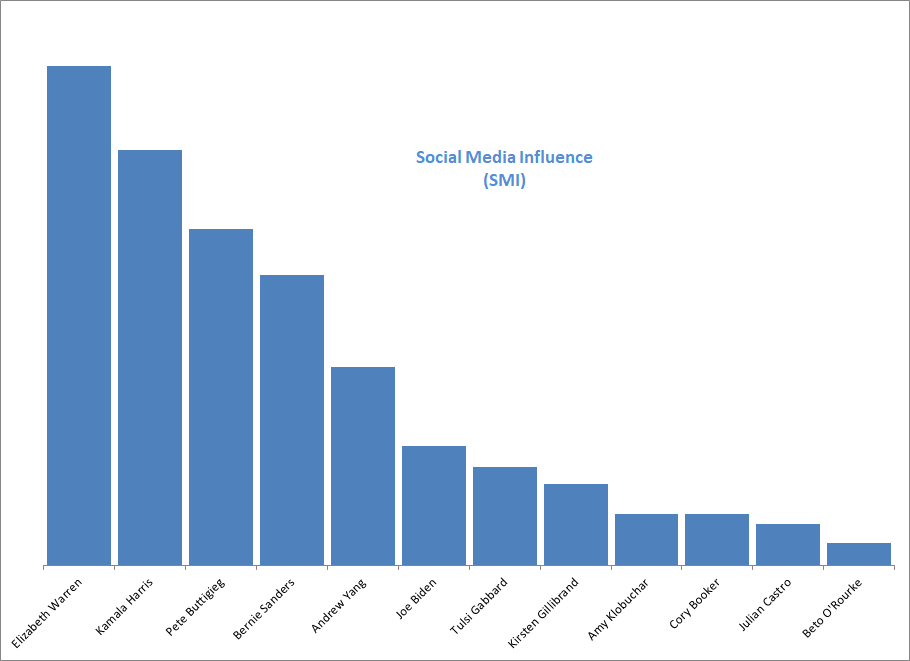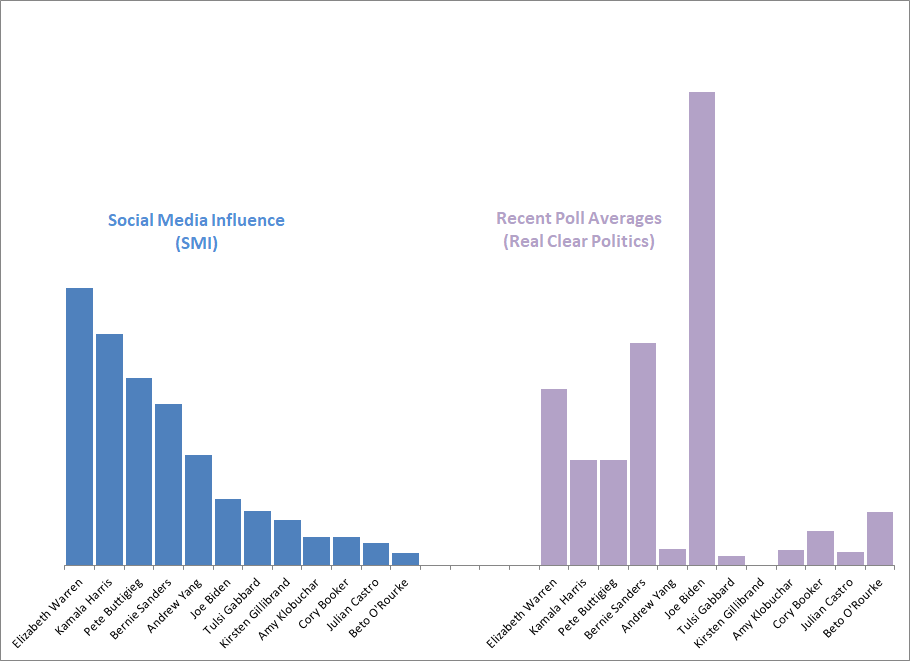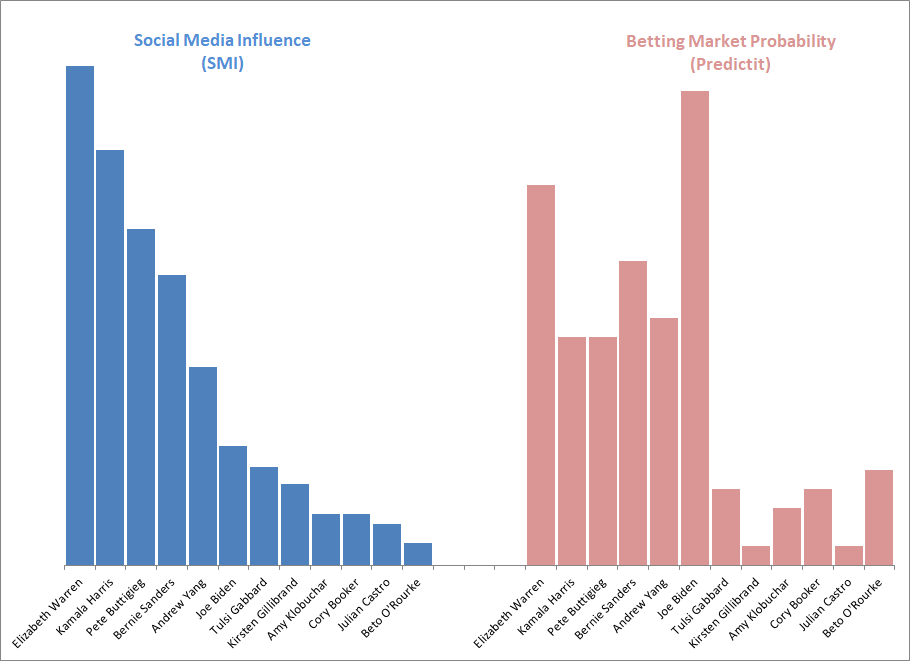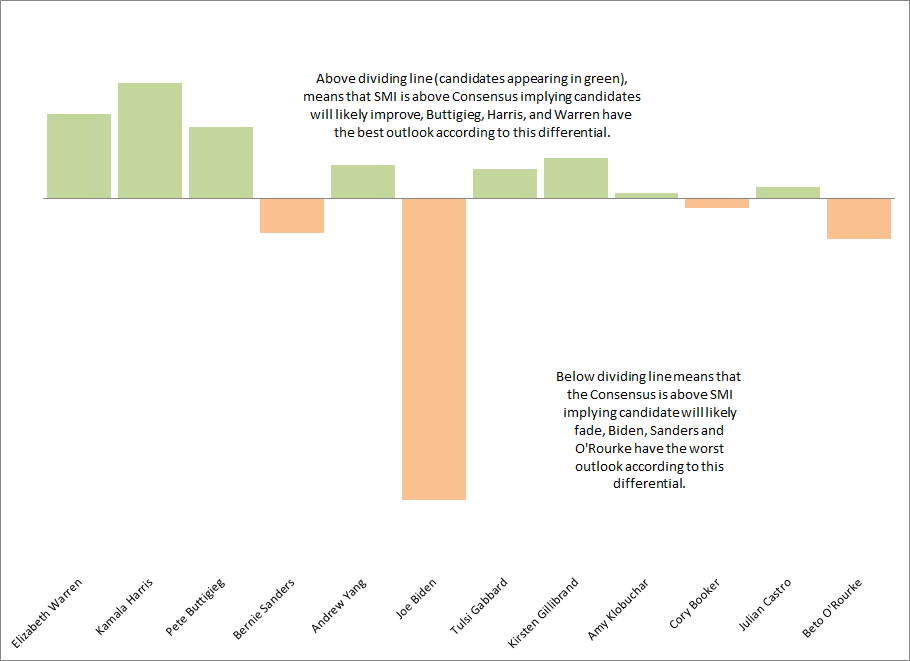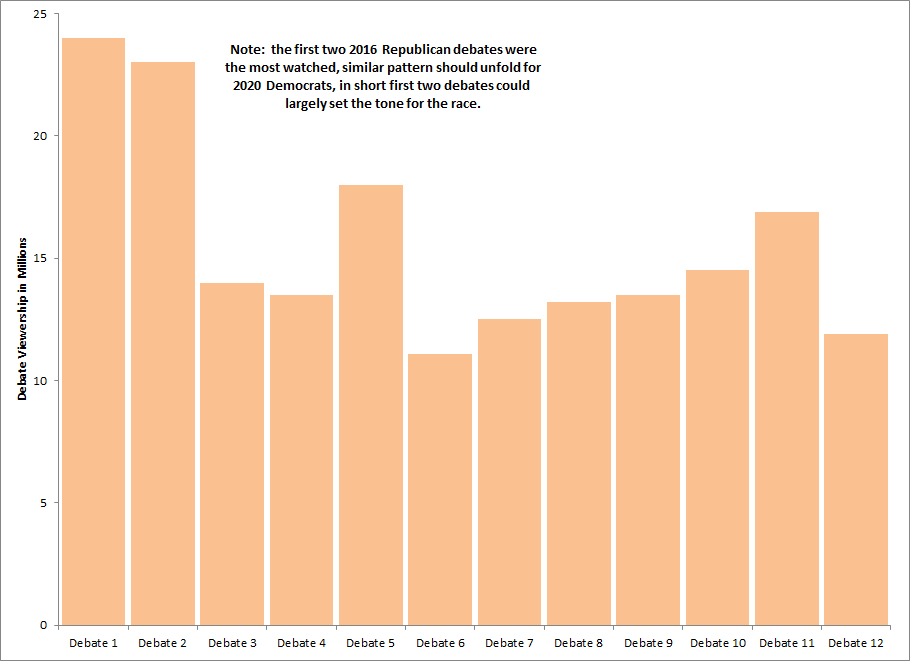Summary
According to Social Media Influence (SMI), Biden and to lesser extents Sanders and O’Rourke look disproportionately weak going into the first round of debates on June 26/27. Having shown relative weakness during the Spring, Biden could effectively be sidelined unless his SMI begins to show more strength in July and August. Considering polls and betting markets point to him as the front-runner, our Biden forecast should be seen as out-of-consensus.
SMI points to Warren, Harris, and Buttigieg as the actual front-runners, with Warren showing the most positive momentum going into the debates. These candidates are the ones to watch to emerge post-debate as the consensus leaders. Yang has emerged as an underdog favorite and enters the debates with an unusually strong SMI as compared to his poll data. Assuming strong performance in the debates, Yang too could become one of the consensus front-runners.
Lastly, it should be highlighted that the first few debates will most likely help determine the outcome of the nomination much more than is presumed. They are not just a warm-up for more serious debates later. In the case of the 2016 Republican debates, the first two pulled the most viewers and generally set the course for the remainder of the nomination. Those Democrats who perform well during the first two debates will likely solidify positions as front-runners as was the case in 2016 for the Republicans.
SMI
Social Media Influence (SMI) is a proprietary algorithm that determines the strength of a subject (such as a political candidate) using only social media data as inputs. It correctly forecasted the out-of-consensus victories of Trump (US 2016 Election), Macron (France 2017 Election), and Bolsonaro (Brazil 2018 Election).
As applied to the 2020 Democratic nomination, the current situation follows:
Exhibit 1: Social Media Influence (SMI) for 2020 Democratic Candidates
Source: ZettaCap
There are a number of observations, many of which that have been highlighted in previous reports, from the SMIs of the Democratic candidates:
- Biden’s Weakness – SMI shows Biden as a mediocre candidate, currently placing him in sixth. Considering he is seen as the front-runner in polls and betting markets, this SMI forecast is completely out-of-consensus.
- Sanders’ Weakness – though not as stark as the weakness of Biden, Sanders places in fourth, which might not appear terrible but considering he is second or third in terms of polls and betting markets depending on the day and considering the strength of his base and social media presence, a fourth place SMI is underwhelming.
- Warren takes the Lead – Elizabeth Warren has recently surged to the lead in SMI. She has been showing positive momentum for the last few months and has just recently taken the lead. Going into the debates, such momentum is a large advantage.
- Harris is consistently Strong – Kamala could be the most underrated candidate of the Democrats as she has consistently produced strong SMI in the face of weakening consensus figures. Currently in second place for SMI, Harris has bounced around in the top three for months. She is definitely one to watch.
- Buttigieg as Dark Horse – months ago SMI projected Pete Buttitieg as the dark horse candidate, meaning he had the potential to go from essentially a no-name candidate to one of the front-runners. He consequently rocketed to the front of the pack and has recently slumped to third.
As we will see, these observations vary considerably from traditional analysis and consensus forecasts.
SMI vs Polls
One of the most obvious takeaways from poll data is that the race appears like a Biden given. In other words, the race does not look very close at all. Biden more than doubles that of the second place Sanders according to average polling data. This type of concentration in a field of 25 candidates (depending on how you count) is astounding.
In contrast, SMI data shows a fairly tight race, with the top four or five candidates within striking distance of the lead.
Exhibit 2: Social Media Influence (SMI) vs Average Polls for top 12 Democratic Candidates
Source: SMI from ZettaCap, Average Poll data from Real Clear Politics
Another observation is the poor showing of Biden according to SMI. In sixth place, he is solidly in the middle of the pack – far from the dominating leadership position shown in polls.
Of all of the analytical methods, polls will most likely change the most over the coming months as Biden’s poll lead evaporates as the electorate reevaluate their opinions after the first (June) and second (July) debates.
SMI vs Betting Markets
Betting markets describe an overall election structure closer to that of SMI in terms of concentration. However, as was the case when looking at polls, betting markets favor Biden.
Exhibit 3: Social Media Influence (SMI) vs Betting Market Probabilities for top 12 Democratic Candidates
Source: SMI from ZettaCap, Probabilities from Predictit
Warren has just recently surged to second place in betting markets. Before this recent move, second place belonged to Sanders. Warren, according to SMI, still has room to move higher. Sanders, as we have mentioned in previous posts, will likely continue to decline.
The candidate with the largest downside, however, continues to be Biden as shown by his leadership in polls and betting markets and his mediocre performance according to SMI.
SMI minus Consensus
Comparing apples and oranges is not advisable but in this case it is useful. Creating a consensus indicator for elections is difficult as each method pulls from different sources and uses different logic. But, we can improve our understanding of the current environment by (unfortunately) creating a consensus indicator by averaging poll (apples) and betting markets (oranges). Understandably, this consensus indicator could be questioned, regardless it does help to provide a better indication early in the campaign when polls and betting markets are thin.
Once we establish this consensus level for each candidate we then compare it to the candidate’s SMI in order to determine the general difference between what is expected (consensus indicator) and what our leading indicator states (SMI). The difference tells us the direction for each candidate. If SMI is greater, we can expect positive surprises from that candidate. If SMI is lower, we can expect that candidate to underperform and for his traditional metrics to decline.
Exhibit 4: Social Media Influence (SMI) minus Consensus Indicator
Source: ZettaCap, Real Clear Politics, Predictit
According to this differential, Harris, Warren, and Buttigieg have the best outlook going forward in that their SMIs most exceed the consensus proxy.
Biden, Sanders, and O’Rourke score the worst using this metric implying that they have the most to fall.
Interestingly, many Democrats have protested this last group of candidates due to their privilege, race, gender, and sexual orientation (in other words, this group represents wealthy straight white males). Grouping individuals as such is questionable, but the fact is that many Democrats see this demographic as having led their party for too long and would prefer to have any other demographic take the lead. Whether this is just a talking point or reality is not being debated here. What we can say, however, is that the Democratic candidates from this demographic are in fact, according to SMI, going to disappoint shortly.
Not Putting its Best Forward
As highlighted in previous posts, the Democratic Party’s strongest potential candidates according to SMI have not declared. Furthermore, as debates are about to begin, it looks like they will not run.
Michelle Obama and Hillary Clinton both possess impressively strong SMIs, especially for non-candidates. Even with campaigns of already declared candidates doing their best to outdo rivals and with debates about to begin, Michelle and Hillary consistently post SMIs that well exceed those of Warren, the current SMI leader of declared Democratic candidates.
SMI shows that if either Hillary or Michelle decided to run, they would have the best chances of not only winning the nomination but also of winning the general election. This has created a rather awkward scenario for analysis as according to SMI the Democratic Party is not putting its best forward. Much can and will change once debates start and the electorate begins to pay more attention to the election, but as of right now Michelle and Hillary look impressively strong in comparison to declared Democratic candidates.
Trump still Expected to Win Re-Election
SMI continues to point to Donald Trump winning re-election.
There are plenty of caveats to reading too much into data at this stage — it is still early in the Democratic nomination process, Democratic debates could kick off increased interest, and the field is still too large for a head-to-head analysis vs the incumbent.
All of these points should be taken into consideration. However, Trump’s SMI remains impressively strong and none of the announced candidates have come close to it.
According to SMI, Democrats will be fighting an uphill battle against Trump going into the general election. Unless there is a significant change, Trump should win re-election.
Debates
The first round of debates is scheduled for June 26/27 and the second round for July 30/31. With 20 candidates participating, these debates will be instrumental in separating the front-runners from the rest.
If the 2020 Democratic debates follow a similar pattern as the 2016 Republican debates, the first two rounds will be the most important and watched.
Exhibit 5: Number of Viewers of 2016 Republican Debates
Source: Wikipedia, note that 2016 refers to the election cycle not the year the debates actually took place, just as 2020 refers to the current election cycle while some debates will take place during 2019.
Clearly, the first two debates pulled in the most viewers, with the first being viewed by more than twice as many viewers as some of the later debates. Many viewers saw enough in the first two debates to more or less decide which candidate to support. Trump, having stood out in the first two early debates in the 2016 election cycle, quickly became the de facto front-runner, after which his position became increasingly unassailable.
Though the 2020 Democratic nomination process is bound to have its own unique storyline, the importance of the first few debates to shake out the unusually large field will likely be similar to that of the 2016 Republicans. We also expect a similar boost to a few select candidates who will become the front-runners.
Conclusion
There will likely be significant shifts in consensus expectations regarding the Democratic race after the first and second debates. SMI, which has acted as a leading indicator for other elections, shows that the consensus favorite, Biden, is a relatively weak candidate. His expected fall, at least according to SMI, will create a significant amount of space for others to rise. According to SMI, Warren, Harris, and Buttigieg are best placed to fill this void.
